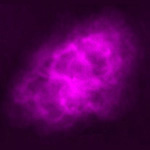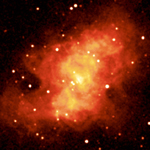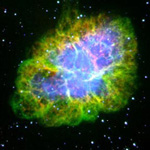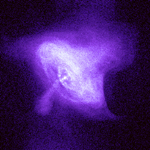AstroCappella: High Energy Groove
| The Crab Nebula | |||
|---|---|---|---|
 Radio image |
 Infrared image |
 Optical image |
 X-ray image |
The Universe in a Different Light
An activity by Kara C. Granger
Activity Summary:
Students will become aware of some of the objects studied in, and concepts associated with, high-energy astronomy. They will do this by participating in card games that teach and review these concepts.
Objective:
Students will realize the importance of observing the universe in many regions of the electromagnetic spectrum and understand some vocabulary terms associated with high-energy astronomy.
Materials for each group of 12 students:
- 12 - 36 index cards
- glue
- scissors
- color copies (optional - for esthetics
only) of high-energy images
- copies of the text contained in each "Did you know?" and "I have...Who
has..."
Introduction:
Some of the objects observed by, and concepts associated with, high-energy astronomy might be new to your students. However, it is essential to share the importance of observing the Universe at wavelengths other than the optical because each region of the spectrum sheds new light on our understanding of the cosmos. For example, some astronomical objects emit mostly infrared radiation, others mostly visible light, and still others mostly high-energy (such as X-ray) radiation. By studying objects at wavelengths other than optical, we are able to understand more about our Universe, including its structure and how it might evolve.
Engagement:
Some of the concepts contained in the lyrics of "High-Energy Groove" are captured in images in this activity plan. These images, along with the "Did you know?" text, and "I have... Who has..." text, can be used to construct and play two card games.
MEMORY
If the teacher wants the students to play "Memory", then he or she should glue the images to one set of 12 index cards, and the "Did you know" text to another set of 12 index cards.
Game procedure for a "Memory" game:
1. Turn all 24 cards face down on a table.
2. Take turns with your group members turning over two cards at a time.
3. In order to collect cards, you must have a match. (For example, the image of the satellite card must be matched with the RXTE satellite "Did you know" text card.)
4. If the cards you chose do not match, put them back, and turn them face down. If the cards do match, you keep them and take another turn at finding a matched pair.
5. The winner is the one with the most cards when all the matches have been made.
I HAVE... WHO HAS?
If the teacher wants the students to play "I have... Who has...", he or she glues the images to one side of a set of 12 index cards, and glues the "I have... Who has..." text to the other side of cards.
Game procedure for "I have... Who has...":
1. Students should be in groups of 12. Each student should be dealt a high-energy card.
2. The teacher chooses who begins, and that student should read aloud the "I have... Who has..." text.
3. In that group of 12, the next person who goes is the one who has the matching image of "Who has...".
4. The group should continue the round until everyone has a turn.
5. The object is to get faster with the round each time.
6. In one class, the group who completes a round in the least amount of time is the winner.
Extensions or Further Discussion:
Students should continue their study and appreciation for observing the Universe in many regions of the electromagnetic spectrum. They may do this by choosing a card and completing a research project that could include an interview with a scientist specializing in high-energy astronomy, or finding additional facts on the chosen card's object and/or images at different wavelengths found that depict that chosen card's object.
References:
The graphics and other information found within this lesson can also be found on the Imagine the Universe! site.
